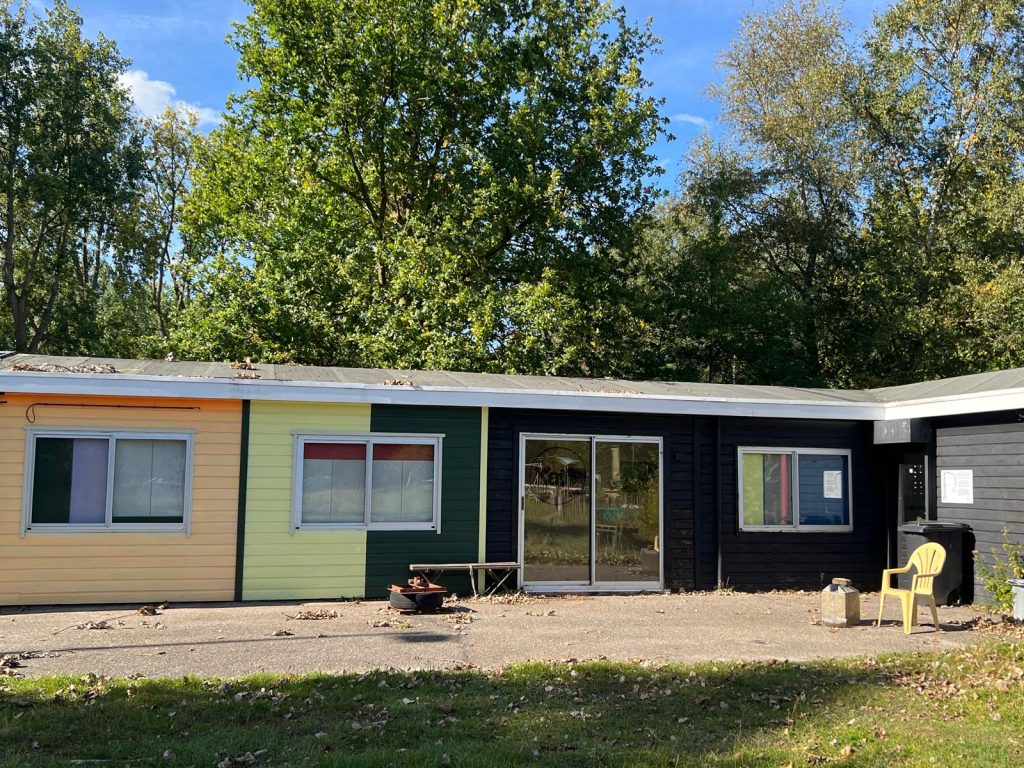
Haridas Contemporary congratulates Jeremy Sharma on a successful 3-month AIR at the Nieuw en Meer guest studio, culminating in a presentation of works produced during the period.
Situated within the beautiful surroundings of the Oeverlanden, Amsterdam, the guest studio offers the ideal environment for artists in terms of personal reflection and concentration, as well as for exchange and collaborations with artists from our community.
This practice-as-research project, that was developed during the Nieuw en Meer Residency proposes an autoethnographic inquiry into painting, travel, and drift. It situates painting not as a self-contained act, but as a dialogic, reflexive process. Shaped by place, memory, conversations and mediation. Its objectives explore the role of the painter as a “passenger” within European art historical and cultural discourse and also interrogate the fragmentation and contingency of images in the context of digital and post-capitalist societies.

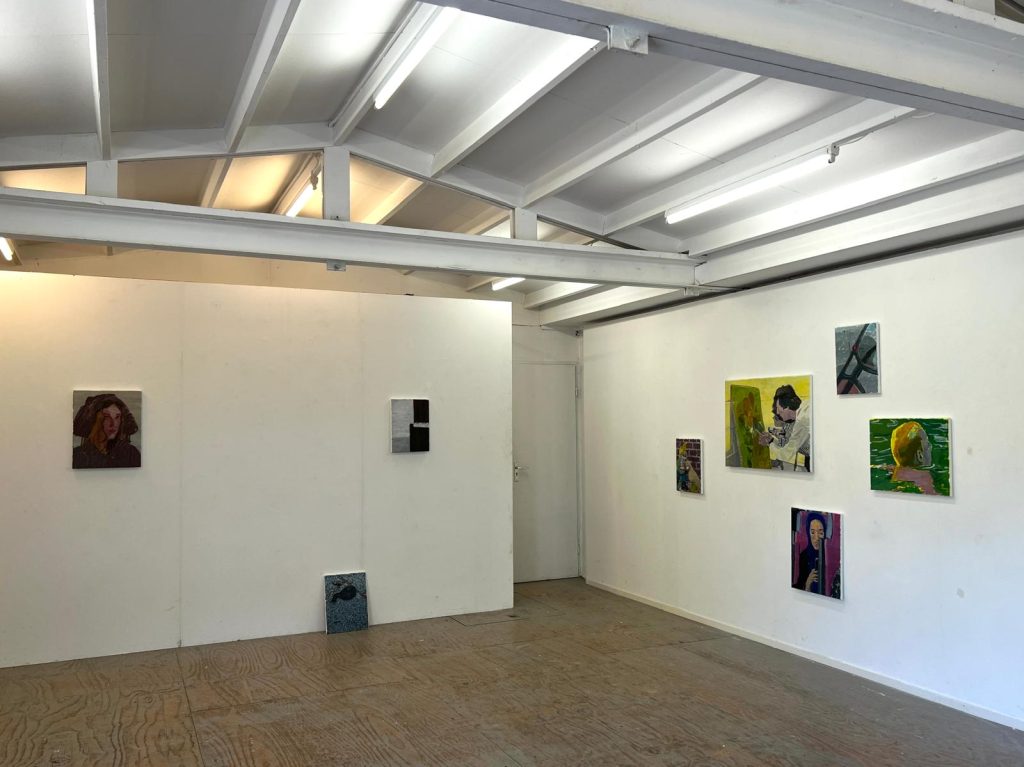

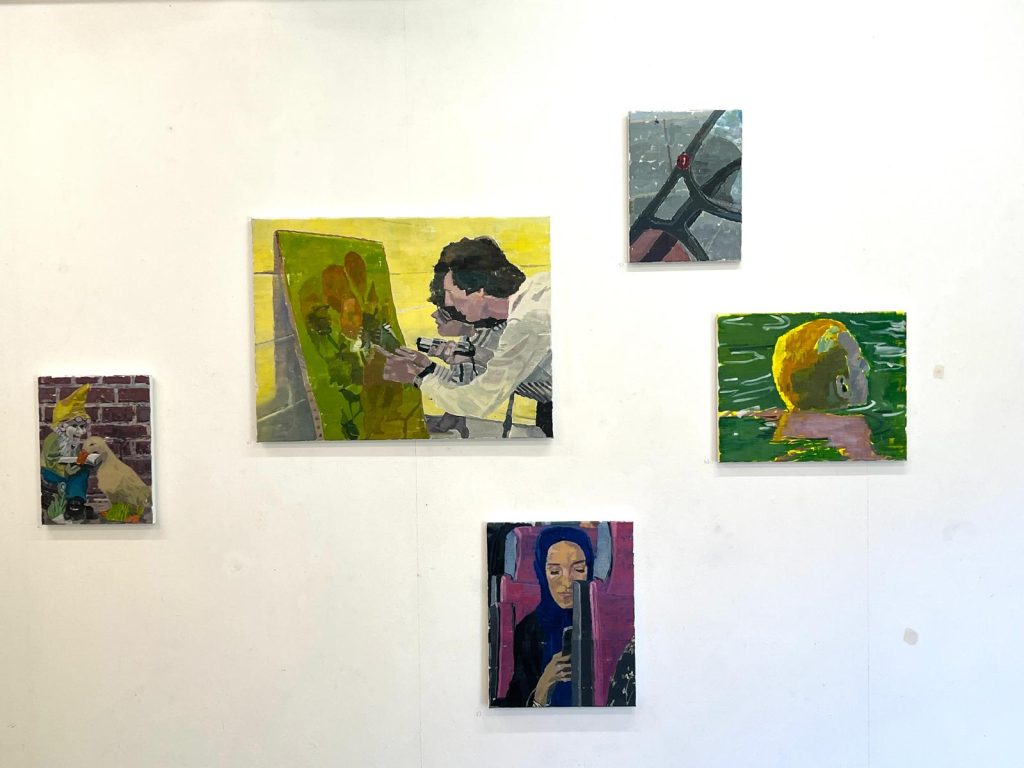
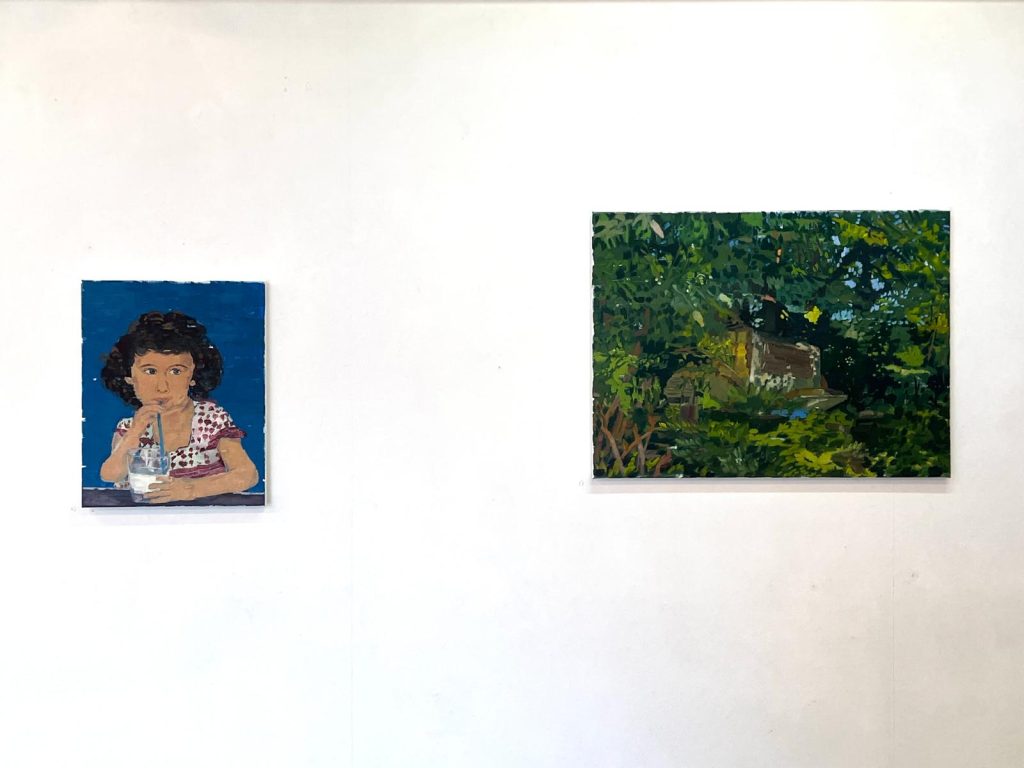
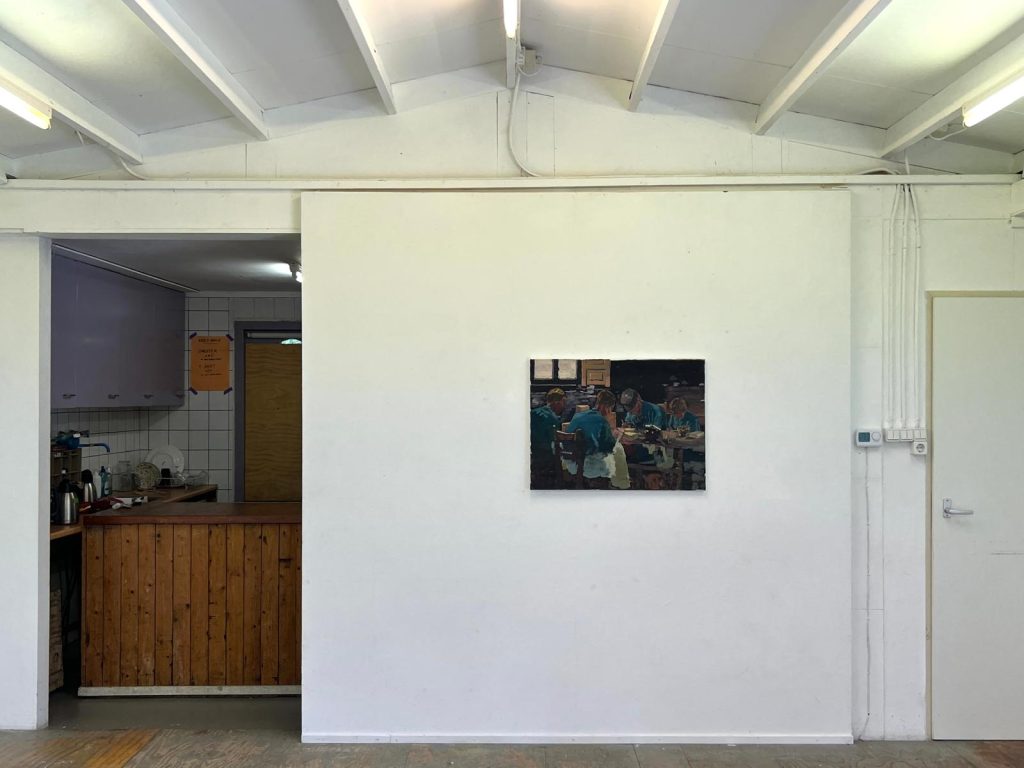
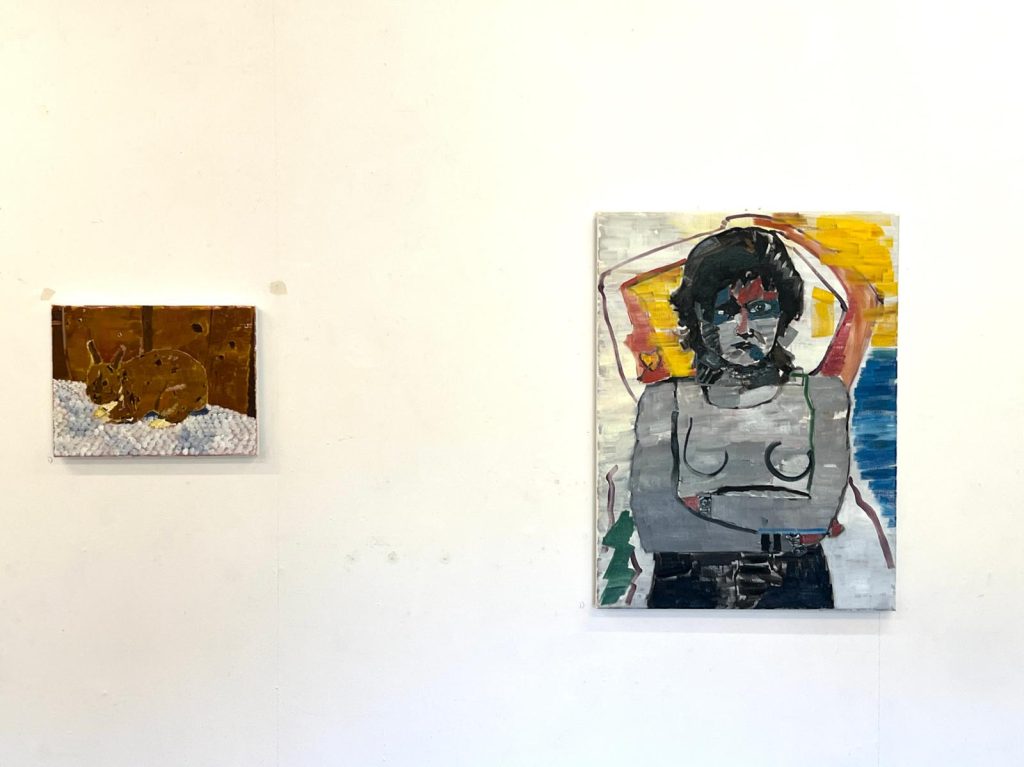
This August, Indonesian-born, Jerusalem-based artist Betty Susiarjo showcases Hening: A solo exhibition featuring twelve mixed-media works ranging from works on paper (using Washi stickers), videos to a wall-installations at CGartspace in Jakarta. Curated by Heru Hikayat, Hening attempts to embody the space between artist and material, and the geographical distance from Susiarjo to her homeland. In the realm of man-made borders and a quest for quietude, Susiarjo blends movement and stillness coexisting in delicate contrast.
Concurrently, Filipino-born, Singapore-based artist John Marie Andrada contributes four new works at Haridas Contemporary in Singapore. As part of Singapore Gallery Month 2025, the exhibition Small Things Brought Together offers the works of nine emerging and mid-career artists as a preview of the gallery’s programming for 2025/26. Andrada’s participation in the group show commemorates Haridas Contemporary’s move to Tanjong Pagar Distripark, marking the gallery’s efforts to cultivate their roster of regional and Singapore-based artists. Andrada’s paintings form the basis of her expanding Undergrowth series, wherein elements of nature become interwoven metaphors for physical sanctuary, desire and growth.
Writer Euginia Tan speaks with Susiarjo and Andrada on their creation process and the significance of their respective shows on their practices. In this conversation, we learn how their resulting works are borne from experiences of grief and hope, amidst breaths and borders.
Euginia Tan (ET): Hi Betty and Marie! Congratulations to the both of you on your respective shows. First off, let’s get an introduction from each of you regarding your practices, and where your interests lie.
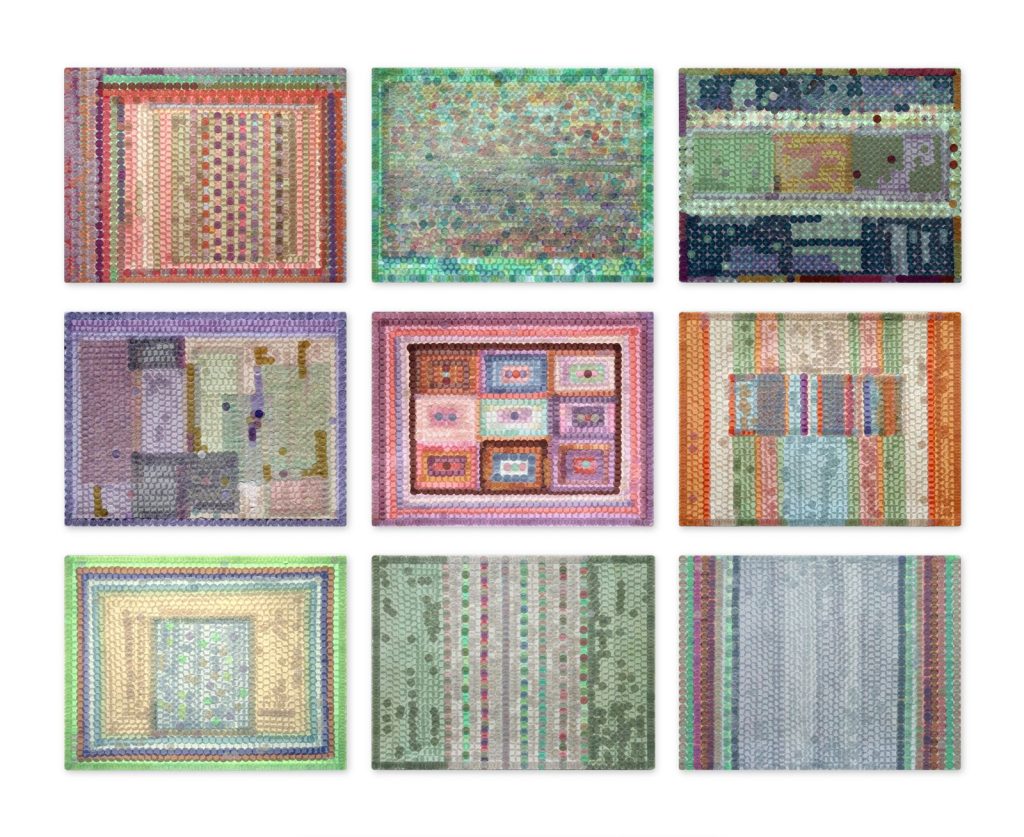
Betty Susiarjo, Evenings (2024-2025), Washi stickers on paper
Betty Susiarjo (B): This solo is a restart for me. I have not been producing works since I became a mother, and my time was intentionally dedicated to my young children. Before this solo show, I have participated in group shows. I enjoy group shows because I get to see my works in varying perspectives with others, many of whom are younger than me: Like Marie’s age! But a solo show is important for me because I can see where my practice is at present, in relation to where I was. When my works are presented in the gallery, I have a clarity of where my practice is currently.
John Marie Andrada (JM): I do echo that solo shows help you see where you are in your practice. I had my first solo last year. For that show, there were image manipulations in the form of video, and paintings. Back in school, I started with oil paintings before I went into photography and video. I realized the way I manipulate image has a painterly quality. So, I’ve been exploring more with painting as a medium and how to expand that.
Right now, my works are a cross between figurative and abstract form. The new Undergrowth series started from an image work I was exploring. Compared to my first solo Breadth of Air, which revolved around grief and absence/presence, questioning identity and home. When I started Breadth of Air‘s topics of grief, I used different mediums (to commemorate) my late grandmother. It turned into a statement of the persevering qualities in love. My practice continues with different ways of manipulating images with inks and testing the limitations of what an image can hold.

John Marie Andrada, In Spring (2024), Oil on canvas
ET: In both your practices, I hear an ongoing journey. Both of you are also practicing away from your countries of birth. Could you describe how you have come to track this internal and external commute emotionally and visually?
B: When I moved to Jerusalem, I started contemplating notions of invisibility, or the unseen. I’m an Indonesian citizen, and both Israel and Indonesia do not have a bilateral relationship. There’s no Indonesian embassy in Israel. I’ve never been in a place where there is no representation or governing body for my country of origin.
With that, I feel like there is an invisibility I am experiencing, because I have limited knowledge of the language and culture in Israel. On the other hand, I’m no longer part of the society I call home in Indonesia, though also not fully assimilated at my current place of residence.
As I’m in this state of wandering, my work emphasizes that transient quality of staying unseen. It’s not trying to hide, but it’s also not being vocal. Whether it is from fear, or uncertainty, or simply the difficulty of explaining the truth.
Very often, what appears in front of us may not be reality. What is unseen may hold more truth. I started to question immediate things that appeared in front of me- for example, social media. That made me realize information can be so easily accessed, but it may not always be accurate.
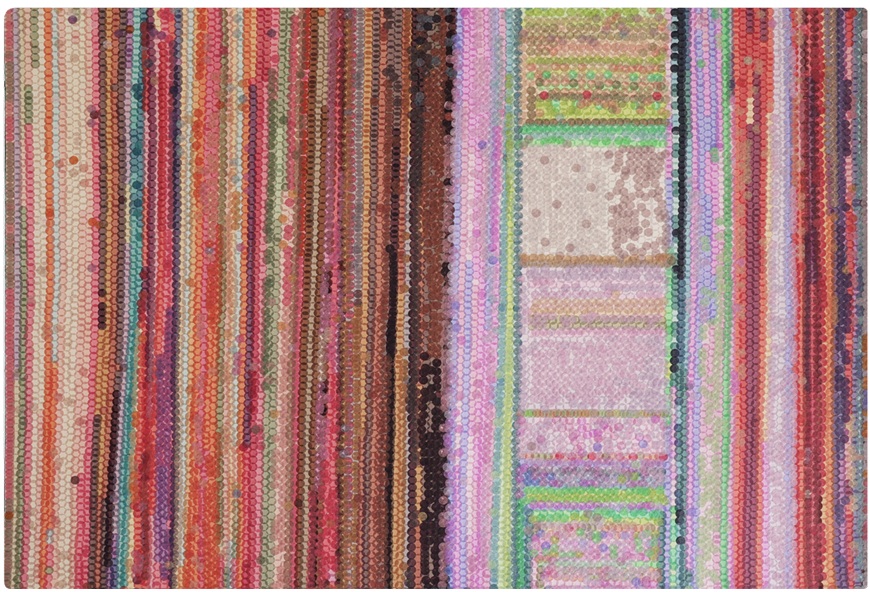
Betty Susiarjo, Earthlight (2024), Washi stickers on paper
JM: For me, I grew up in the Philippines where we had a backyard. Moving to Singapore into a HDB home, there was an estrangement with nature. That influenced my new series which uses our closeness with nature as a vantage point to internal landscapes. I’ve been trying to address and reconcile the gaps of being invisible too (which Betty mentioned). With my paintings, I try to bring up a presence in the absence that is felt in certain situations.
Parts of our human body remind me of the elements of nature. For example, caves may look like our ears, our veins can look like roots, vice versa. I’ve tried to incorporate such imagery into my work and pondering what is real also intrigues me. Materially, I attempt to make images more tangible than they are perceived to be.
My paintings are intuitive in movement. The making process is hands on, what you leave on your canvas is a residue of your thoughts. In that way, there is a kind of transfer akin to moving to different places in the world. Where you go to or reside will influence and evolve your practice. Ironically, sometimes being away brings you closer to home.
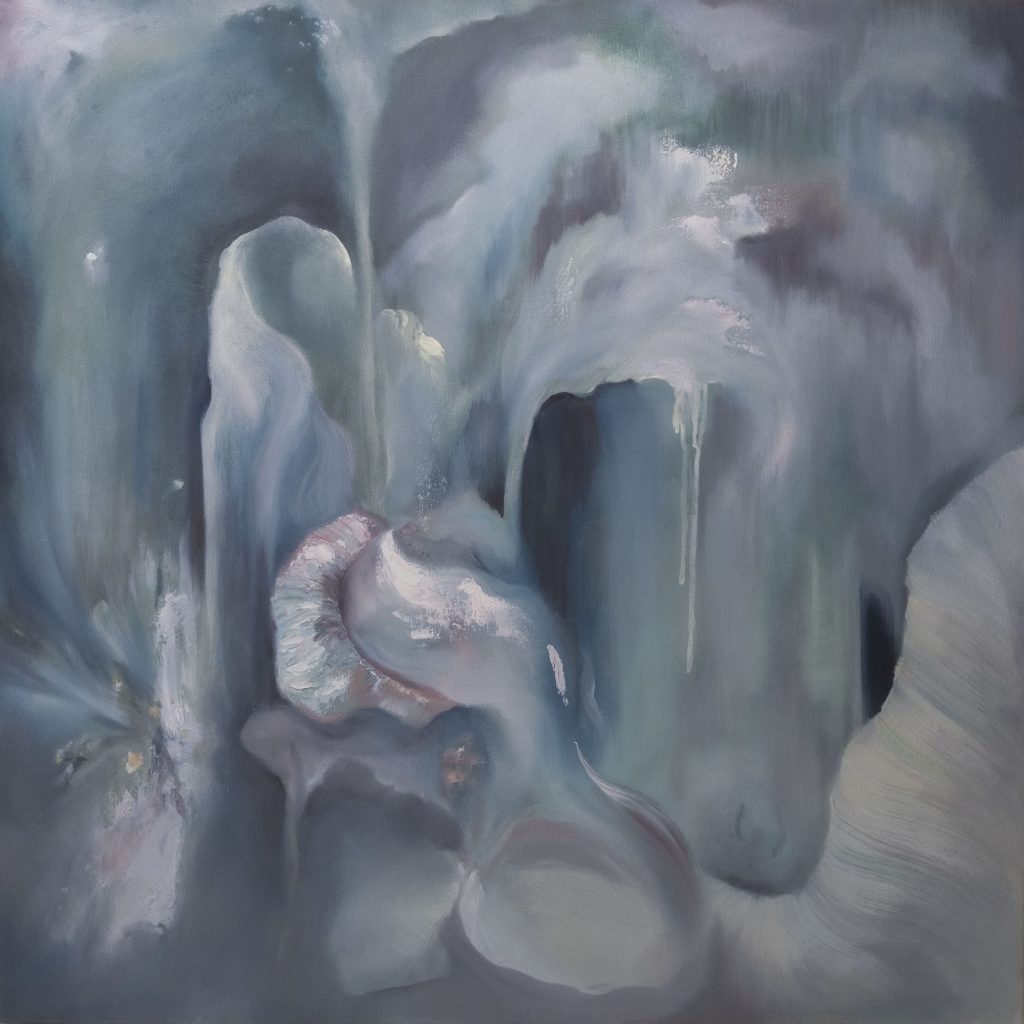
John Marie Andrada, Reprise (2024), Oil on canvas.
E: I appreciate how both of you describe your processes with identity, transfer and liminal possibilities in migration and artmaking. In all your works demonstrating surface manipulation, whether it is via painting, video work, object installation: Could both of you explain how you perceive surfaces and what it means to include and manoeuvre them to your surroundings?
JM: When I first learnt about painting, it was taught as something two-dimensional. As I refer more to it, it encompasses other dimensions via the colours and compositions on the canvas. With sculptures- There is a lot to think of in their layers, even digitally. Everything is dynamic when you can see this connection through various mediums. This connection can be translated from one form to another. For me, surfaces are a way to describe a plane. From there, there are infinite ways to play around and interpret it.
For an everyday object, if you remove their context -for example in Betty’s washi sticker series- The stickers become another conduit depending on how you piece them together. There exists a tactility which screens cannot convey, in today’s conditions.
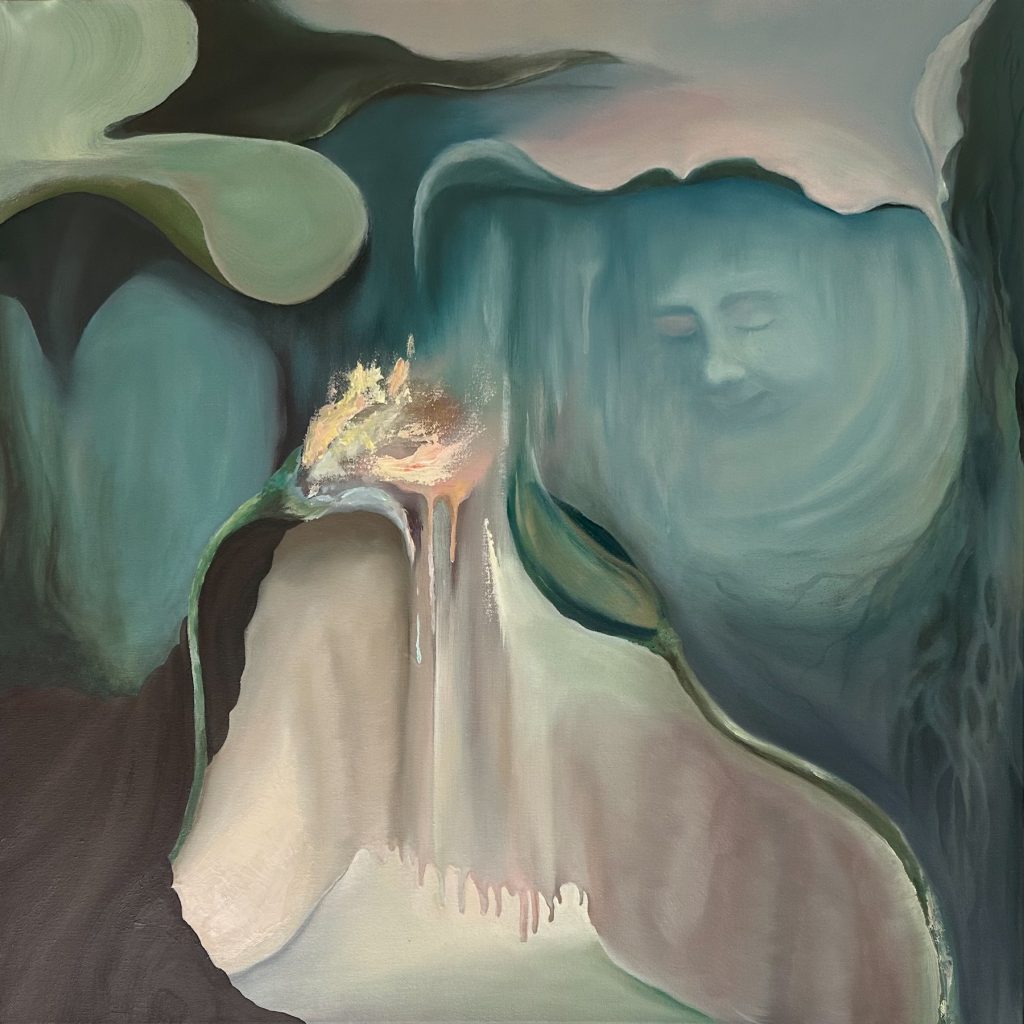
John Marie Andrada, Winter Spring (2025), Oil on canvas.
B: We live in a world surrounded by items and materials. From stationery, to toys, to industrial objects… All these objects excite and stir possibility. There is a desire from our hands to interact, touch and make something out of them. For example, in my work The Consistency of Flow, I use thread and nails on the wall. This work was created when I was a student, and I was testing stitches on paper.
I thought this could be transferred to a wall, wherein the wall is the paper. The threads were then fixed with nails. Now, this work is relevant to me again. In response to Marie’s observation, I do feel our innate tactility is heightened too, especially across the generations we were born in, where we witness the production of goods at its peak. As we are exposed to materials, we naturally become curious about their surfaces.
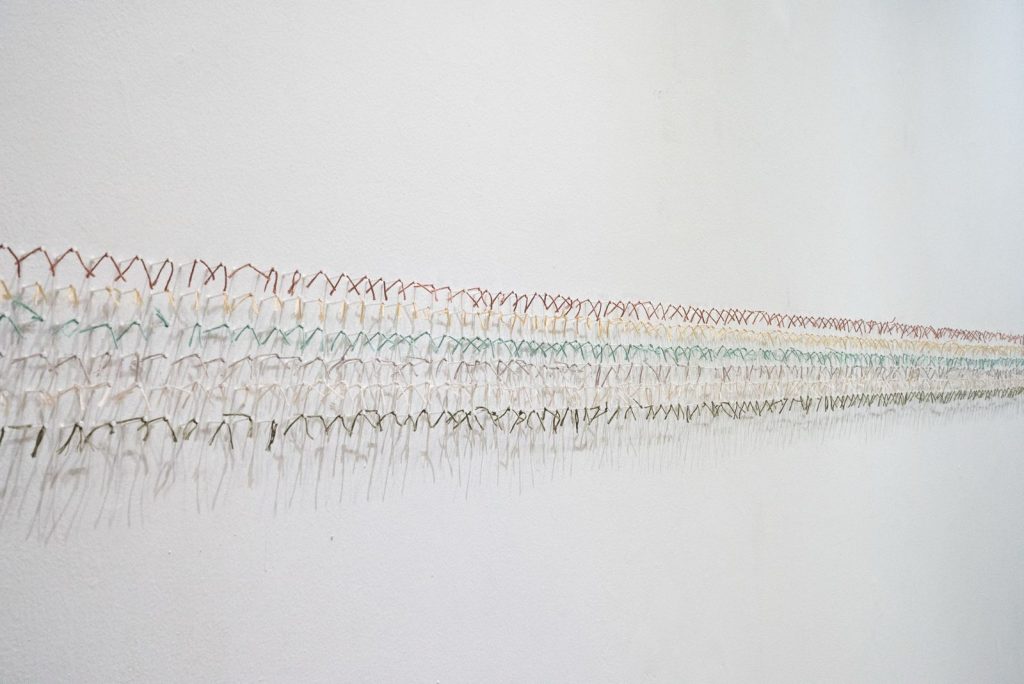
Betty Susiarjo, The Consistency of Flow (2025), Nail and thread on wall
ET: I’d like to delve into the titles of your respective series Undergrowth (by John Marie) and Hening (by Betty Susiarjo). What drew you both to these titles and their definitions for each of you?
B: For Hening, the curator selected this title based on his reading of departure and returning in my works. Initially, he suggested that there may be some longing for home. Home as comfort, rather than a physical home.
I do agree that I am yearning for quietude and silence. In the repetition of my making process, I find some solace from everyday life. It made me question what it meant for me to make art. I realize artmaking is carving space and time for oneself, to dispense full attention into something not quite there yet. The art is becoming, and we have to be there for it.
This roots me because the nature of our attention is fragile. As we become immersed in our practice, we realize the significance of attention we grant to our work. This attention is also an experience of beauty.
In our daily lives, our attention is constantly broken down. For now, we are conversing. Soon, I’ll have to get back to the gallery or the kids. Hening represents a purposeful silence, by choice.

Betty Susiarjo, A Dazzling Grey (2019), Video
JM: The fact that Hening doesn’t have a direct translation is poetic in itself! I can’t agree more that attention and time is crucial to your practice. I can’t create when I’m angry, or if there is too much noise. The setting of a space needs to be conducive because when we’re creating, it’s an intuitive process. You need attention to sense the next step.
I chose Undergrowth as my series title to describe the undergrowth of a forest. There is a network below we can’t see, as things grow. Since our bodies are composed of water, there is a resonance with how fluid our emotions are. We constantly change between states. Undergrowth represents something that is always shifting, even if we don’t see it at first sight.
I’m trying to draw comparisons from our body parts and earthly elements. I’d like for it to be a reminder that we are not too separate from nature. At the same time, the works serve as imaginary landscapes. While I incorporate the portrayal of actual flora and fauna, they are suggested rather than affirmed.
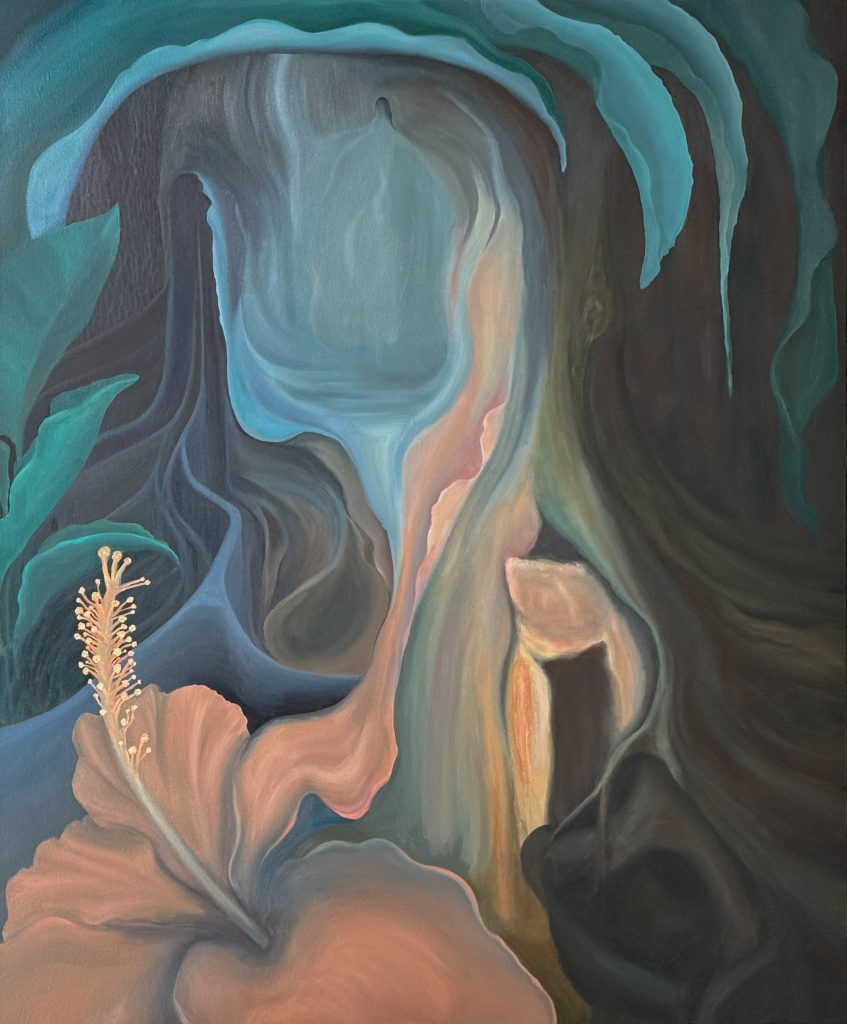
John Marie Andrada, Beyond the Tree’s Hollow (2025), Oil on canvas
B: Some titles of works came to me because I live in the desert. The desert is not a landscape I am familiar with; I grew up in tropical countries where colours are vivid and lush. In the desert, it is mostly ochre. However, the more I familiarized myself with the desert landscape, the more I began to see colours. If you look carefully, there are small signs of life. The sunset against the sky is dramatic.
Living in the desert inspires me and taught me what is essential. Many items become distractions. Our possessions become ‘too much’ when they are brought to the desert. This changed how I viewed things, from my practice to the interior of my house. I think the desert is a turning point for artists. If I personify getting to know the desert, I will describe this person as cold and reserved. They can be hard to like at first. But the desert also has a feminine quality, amidst the sand and rocks. My heart unfurls in the desert.

Betty Susiarjo, The Scent of Rain on Sand (2025), Washi stickers on paper.
JM: For me, the obscurity of the undergrowth compels me. People are like trees. We grow and go through seasons. To draw parallels to the undergrowth, we never fully know what a person goes through, just as how the undergrowth never reveals itself but keeps thriving.
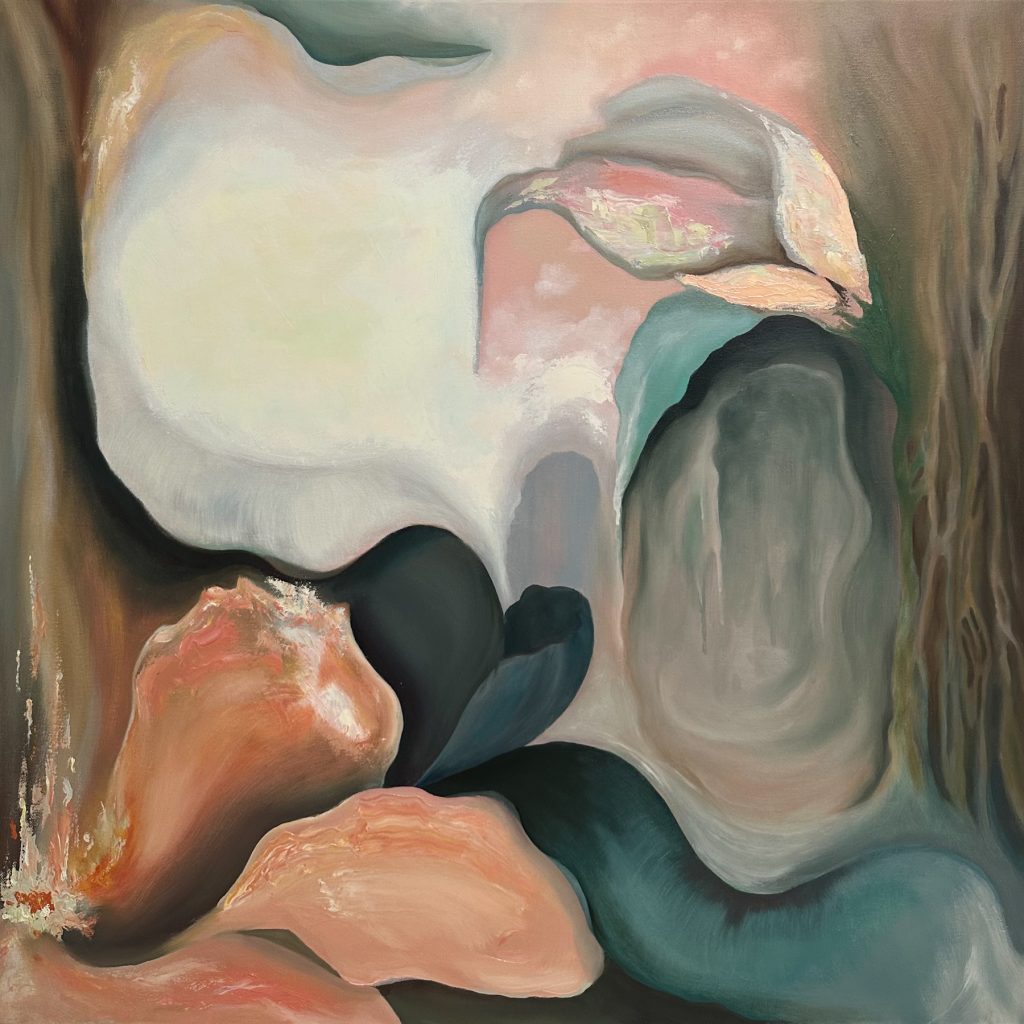
John Marie Andrada, In Bloom (2025), Oil on canvas
ET: Thank you for your time with me today! For my last question: As active artists from different generations, how does it feel to meet at intersections with your works?
B: This must be encouraged! There is a lack of conversation generally, between artists (of different generations). We are asked often of our individual practices, but it is also fun to hear another perspective and viewpoint. This informs me of how artmaking practices respond to time. Certain things come and go, while some sustain. I would love more of these encounters to happen, across continents and cultures.
JM: While artists come from different walks of life, the common thread of artmaking is enough to bind us. In these exchanges, we experience glimpses of our thoughts and routines. There is only so much we can emphasize on as individuals. These conversations help us feel connected, enriched and hopefully reach into other depths of our practices.
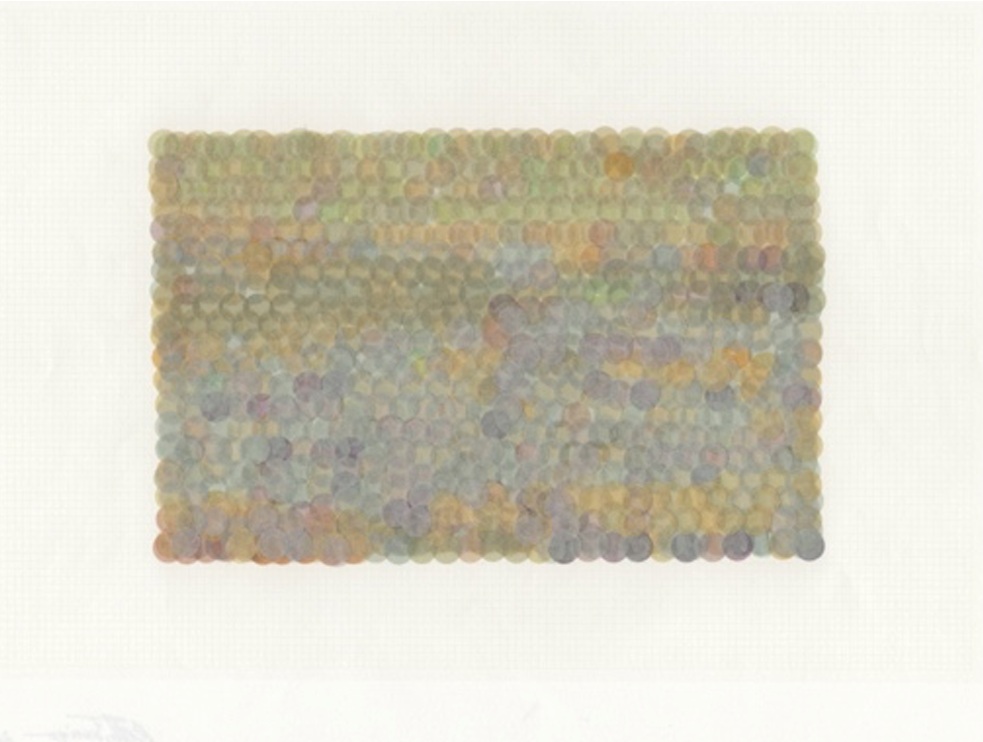
Betty Susiarjo, Concrete Poetry (2024), Washi stickers on paper.
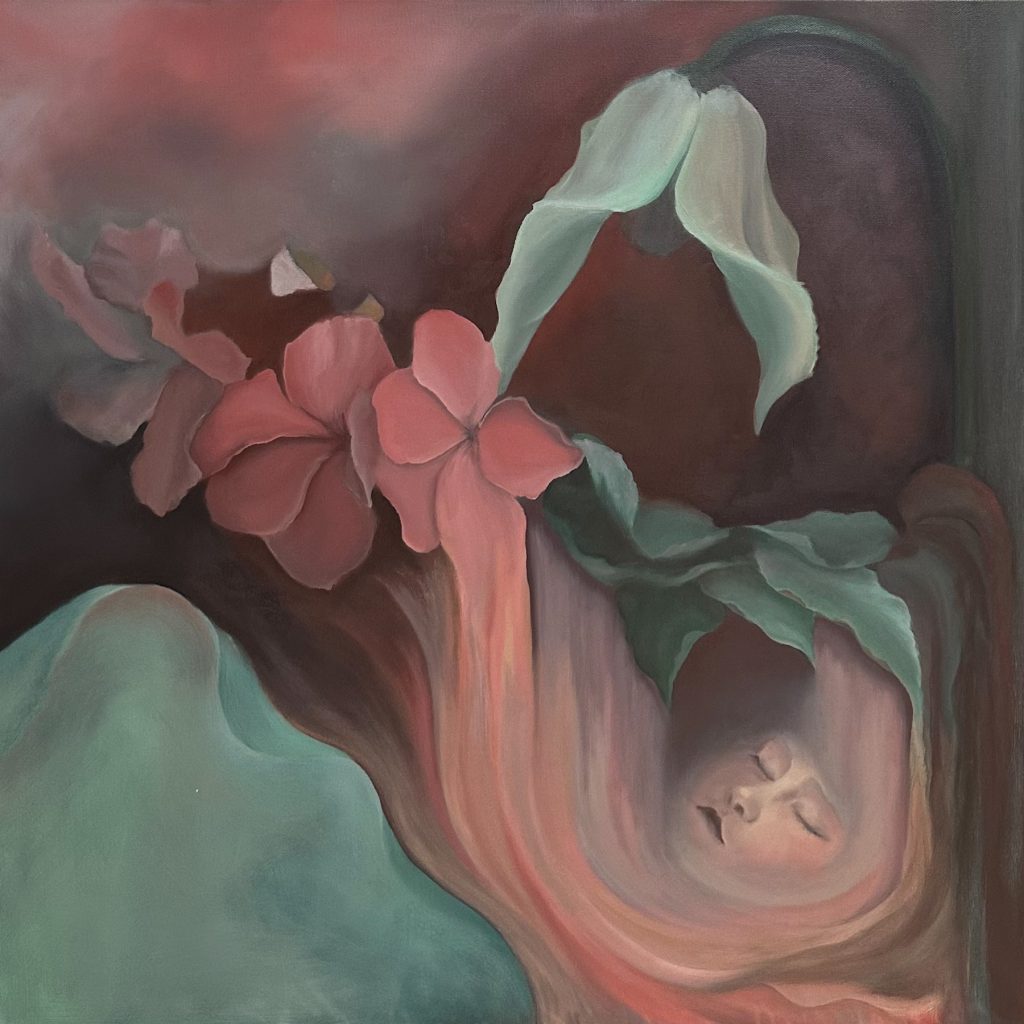
John Marie Andrada, Autumn Fall (2025), Oil on Canvas
ARTIST BIOS
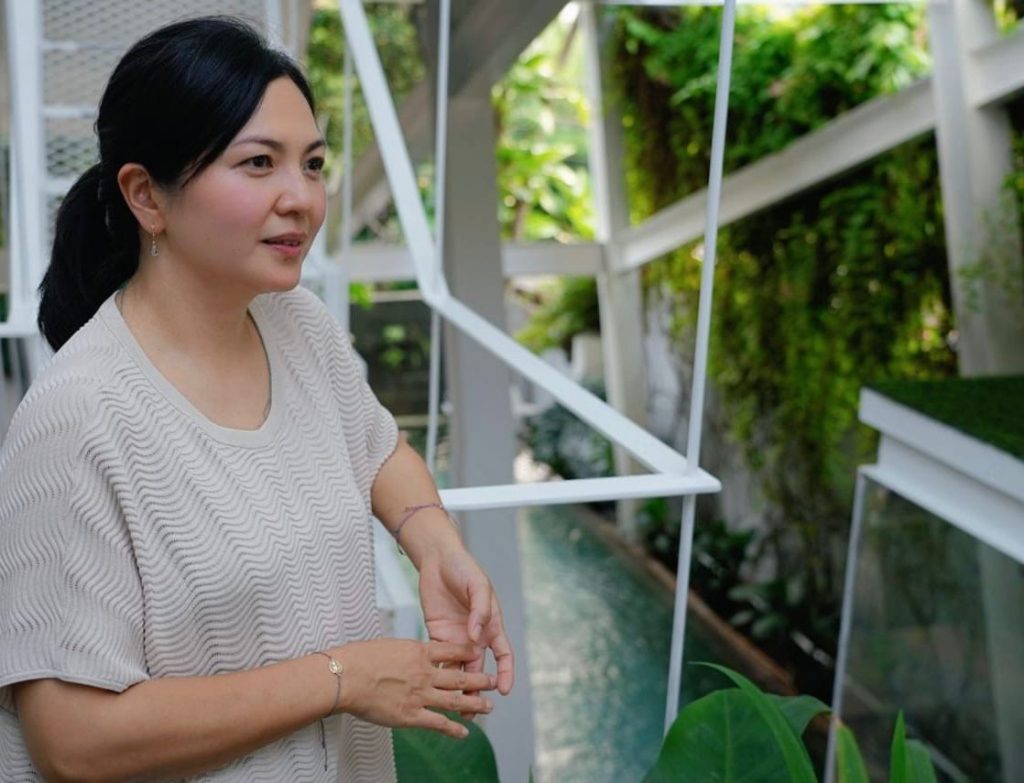
Betty Susiarjo (b. 1980) is a mixed-media artist whose work engages concepts of temporality, materiality and sublimity. She received her MA (Fine Arts) with Distinction from Winchester School of Art, England and her BA (Fine Arts) from Surrey Institute of Arts and Design, England.
Influenced by the studies of physics and metaphysics, her work seeks for an awareness of a moment presented in a particular time and space, thus providing a poetic realm for contemplation. In recent years, her research has inclined towards the study of light, shadow and the unseen and how their qualities affect our experience and encounter with beauty. Employing some element of craft to her work, she juxtaposes methods such as sewing, embroidery, beading etc. to create visual sensations that lie between the perceptible and the illusioned.
In 2016, her work has been shown at Motions, a multi-media exhibition in OTA Fine Arts, Singapore and Tokyo, Japan; as well as A Dazzling Grey, an artist residency in Fukuoka, Japan. In 2017, she was a participating artist Changing Perspectives in ARTJOG 10, Yogyakarta, Indonesia; and created The Blue Who Swims All This Way for an exhibition at The National Gallery, Singapore. In 2019, she participated in Personal Structures: Identities, hosted by the European Cultural Centre, in the context of Venice Biennale, Italy.
Hening runs till 31 August 2025 at CG Artspace, Jakarta (https://www.instagram.com/cgartspace/).
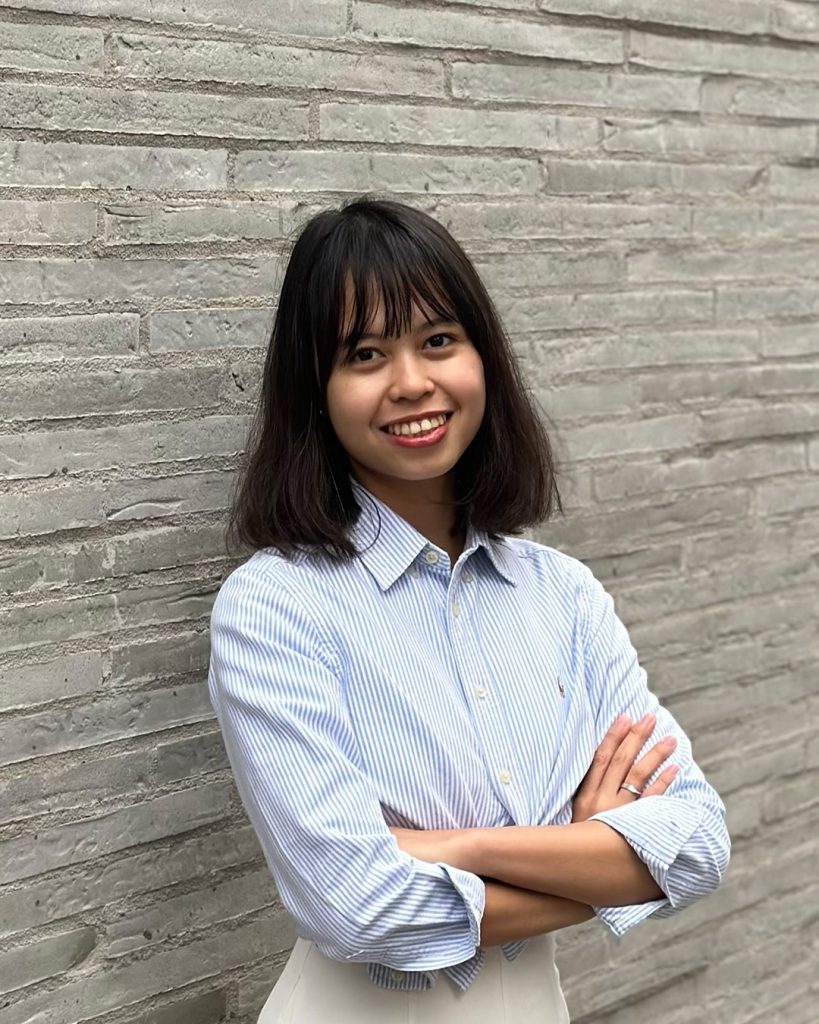
John Marie Andrada (b. 2001, Philippines) is a multidisciplinary artist based in Singapore whose work spans painting, installation, sculpture, photography and video. Growing up and taking root in a once foreign country, she moves between mediums, drawing from personal recounts to reflect on the complexities of identity, time and the human experience. Defined by an ongoing investigation of how narrative and visual language can intertwine, her practice blends figuration and abstraction, driven by an intuitive, experimental approach to image-making. Andrada graduated with a Bachelor in Fine Arts (First Class Honours) from LASALLE College of the Arts in partnership with Goldsmiths, University of London in 2023. In 2024, she debuted her first Solo with Haridas Contemporary, Singapore. She was a recipient of The Winston Oh Travelogue Award (2023) and the 41st Daegu International Grand Exhibition Special Choice Award, Korea (2022). Her works have also been featured in Japan, Istanbul and China.
Small Things Brought Together runs till 31 August 2025 at Haridas Contemporary, Singapore (https://haridascontemporary.com/exhibition/small-things-brought-together/).
WRITER BIO
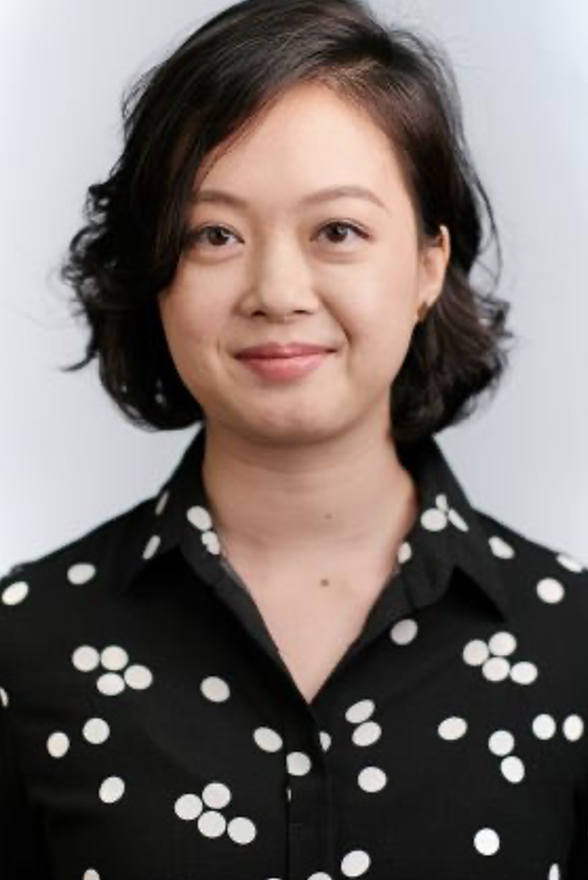
Euginia Tan is a multi-disciplinary writer based in Singapore. She has experience in an array of written forms including poetry, prose and playwriting. She has written curatorial essays for visual artists such as Melissa Tan, Hu Qiren and Faris Nakamura, to name a few. Euginia’s analysis explores and covers contemporary practices, their range of mediums as well as her personal take on creating conditions in Singapore and Southeast Asia, and its various impacts on artists.
Titled after a video-essay by artist Korakrit Arunanondchai – one of the most adroit chroniclers of our zeitgeist – this exhibition explores the contemporary condition through the eyes of a younger generation of artists.
Their searching works convey a sense of vague disquiet, distractedness, fleeting intimacies and estrangement: fragments of an age and hyper-digitalised consciousness where signs are often unmoored from their referents; where the speed at which information is written and overwritten results in a collective amnesia.
By turns surreal, tender, and unsettling, these interior worlds attempt to evoke and remember relationships, identity, history and meaning, even as these slip from our grasp.
“Quarter Past” and “Departure” are Loh’s attempt at capturing a certain emotional resonance in pictorial form. Drawing inspiration from artists such as Edward Hopper and Singaporean photographer Nguan – who adroitly captured scenes of urban alienation, solitude and tenderness – Loh’s paintings speak of an introvert’s desire to escape the ‘noise’ and hyper-activity of a fast-paced city like Singapore. The stilled, cinematic quality of these paintings express what the artist describes as “an inevitable longing to be in a different place or time”, while simultaneously suggesting a subtle connection between people, time and space. The blurred, translucent figures of these tableaus evoke a certain ambiguity and surrealism within their settings, suggesting a fleeting collapse of temporalities: they are like ghosts or traces of a prior presence in a particular space and time.
Click on link for more information: https://appetitesg.com/event/theresaword/
Paving Paradise reflects the constant upkeep of Singapore’s everchanging urban landscape. The restructuring of our city reflects the restructuring of our policies to mitigate the threats of urbanization, highlighting our dream to transform Singapore into a City in Nature. Our desire to develop harmoniously with the flora and fauna takes shape through our city features such as roads, pathways and bridges which cater for people and animals alike, connecting green spaces within our urban environment.
Haridas Contemporary is excited to announce our representation of emerging Singapore-based Filipino artist John Marie Andrada (b. 2001, Philippines).
Andrada is a multidisciplinary artist whose work spans painting, installation, sculpture, photography and video. Growing up and taking root in a once foreign country, she moves between mediums and draws from personal recounts to reflect on the complexities of identity, time and the human experience. Defined by an ongoing investigation of how narrative and visual language can intertwine, her practice blends figuration and abstraction, driven by an intuitive, experimental approach to image-making.
Andrada graduated with a BA in Fine Arts (First Class Honors) from LASALLE College of the Arts in partnership with Goldsmiths, University of London in 2023. In 2024, she debuted her first Solo with Haridas Contemporary, Singapore. She was a recipient of The Winston Oh Travelogue Award (2023) and exhibited in DECK’s Undescribed #9 helmed by John Tung and Robert Zhao. Her works have been nominated for International Takifuji Art Award, Japan (2022), featured in Project 3V (Visualize, Voice and Vision) at FassArt Gallery, Istanbul (2021), 9th Dali International Photography Exhibition (DIPE), China (2021), and received the Special Choice Award for the 41st Daegu International Grand Exhibition, Korea (2022).
Works by Jeremy Sharma in The Other Lives on Painting @ ADM Gallery
Catch ‘The Other Lives of Painting’ curated by Michelle Ho
On View Now @ ADM GALLERY till 21 March 2025
Featuring paintings by Jeremy Sharma
And other works by Sookoon Ang, Kiat, Nicholas Ong & Joanne Pang
A continuation of ADM Gallery’s 2019 exhibition ‘Reformations: Painting in Post-2000 Singapore Art’, which explored artists’ engagement with the materiality and methodologies of painting.
“Creating a sense of dislocation that mirrors the way in which we engage with images in an increasingly media-saturated world, Jeremy Sharma’s body of work can be seen as an exercise in merging the domains of film, literature and popular culture, using painting to blur the boundaries between these realms of knowledge. In this series, the artist refrains from privileging one particular interpretation or narrative over another, disrupting traditional modes of storytelling and visual representation. Instead, Sharma’s focus is on the shifting frames or reference that move across the works, each painting acting as a site of transition where contexts and symbolic meanings migrate and transform.” – Michelle Ho
More information about the show on ADM Gallery website: https://admgallery.sg/
Melissa Tan Achieves Artist Record High at Art SG 2025
Straits Times reports sale of Melissa Tan’s monumental triptych The Fates: Klotho, Lachesis & Atropos (2024) to regional private museum for an artist record high.
Read Full Article here: https://www.
Access Clare Elson’s full interview via the link: https://snapsartandartists.
Art & Market Editor, Ian Tee (@ianteestudio), reviews Melissa Tan’s current body of work in her latest exhibition at Haridas Contemporary. An insightful piece for anyone who is interested in understanding more about the formal qualities in the works. The piece serves as an excellent complement to independent curator, Tan Siuli’s (@the.itinerant.curator) essay in the exhibition eCatalog.
Access Ian Tee’s full review via the link: https://artandmarket.net/reviews/2024/11/8/melissa-tans-parts-shared-allotted-portions-at-haridas-contemporary
Cipher presents a series of works created during the pandemic, when Sharma spent most of his time at home, looking at images of the world outside through his computer screen. The artist collected images from the news and various media sources, and layered and collaged them using Freehand software, where he processed the raw images by subtracting details so that only vague outlines of the forms remain. Sharma’s artistic intervention determines the degree of abstraction of each composite image, and in how he chooses to fill in certain areas with colour to create rhythm and suggest new forms.
The result is a composition that retains vestiges of the original images, coalescing into a new one in our mind’s eye. These works hover tantalisingly between figuration and abstraction: we can half-decipher parts of it, but full legibility eludes us, like a code that must be cracked – a visual cipher.
Click on link for more information: https://appetitesg.com/event/cipher/
A sharp and concise piece for anyone who is looking to catch up with Sharma’s artistic trajectory.
Access the full article via the link: https://artandmarket.net/
Congratulations to Melissa Tan on unveiling her new public artwork, The Darkness which Reveals at the new Siglap MRT station, as part of the Land Transport Authority (LTA) Art in Transit programme.
Also, congratulations to the other artists involved in the project including Bani Haykal (Tanjong Rhu Station), Sit Weng San & Tania De Rozario (Katong Park Sta.), Sim Chi Yin (Tanjong Katong Sta.), Ang Sookoon (Marine Parade Sta.), Moses Tan (Marine Terrace Sta.) and Bruce Quek (Bayshore Sta.)
Commuters will be able to enjoy the artworks of all mentioned artists when Stage 4 of TEL officially opens on 23 June.
|About the Artwork|
The origin of ‘Siglap’ may be traced to a 19th century solar eclipse that occurred in tandem with Tok Lasam’s arrival by ship under the cover of darkness. Siglap is derived from the Malay word, ‘Gelap’ which means darkness that conceals.
The Darkness which Reveals references the method in which the terrain of the moon is studied. In space the strength of light can help determine the distance of objects far away. This work utilized mapping data which shows the moon’s uneven surface and shadows. The metal perforations are transmuted from these shadows. Just as the moon reflects sunlight, the reflective metal mirrors this phenomenon, providing an illusion of iridescence.
Darkness is reconsidered, not as concealing, but as revealing information and fragmented stories of Tok Lasam’s arrival by sea.
Image Credit: Artist Melissa Tan with her work, The Darkness Which Reveals, at Siglap station. ST Photo: Kua Chee Siong
Access the full article via the link:
https://www.straitstimes.com/singapore/transport/time-after-time-a-first-look-at-new-art-in-transit-installations-at-tel-stage-4-stations
We are delighted to share a discerning review of Jeremy Sharma’s recent solo exhibition in Artforum’s May 2024 Issue, Vol. 62, No.9. The exhibition ran from 13 Jan – 9 Feb 2024.
Review excerpt, “Even where the content of their imagery engages with history or politics, the paintings as an ensemble eschew taking any definite stance. They are not about catching a moment or halting time, or dissecting lives lived through social media, as with other painters using photography. Sharma does not seem to be concerned with fidelity to the photograph. What comes to the fore is touch or texture; and, reflecting on this, one realizes that even in Sharma’s video and sound works, there is always a palpable sense of surface.”
Full Article Link: https://www.artforum.com/events/sherman-sam-jeremy-sharma-haridas-contemporary-2024-553073/
Haridas Contemporary is delighted to announce representation of dynamic Singaporean painter, Esmond Loh (b. 1995).
Loh works primarily in painting. His current body of work explores the theatrical. Taking inspiration from his memory and imagination, he creates dramatic and ambiguous scenes that combine both abstract and figurative elements.
He graduated in 2019, with a Bachelor of Fine Arts (First Class Honours) from the Slade School of Fine Art in London, United Kingdom. He won the prestigious UOB Painting of the Year Award in Singapore in 2012 when he was 17 years old, for his first attempt at oil painting titled Just Let Me Sleep. He also won awards in the same competition in 2018 and 2020 respectively. His works are part of private collections in Singapore, Malaysia and the UK.
Haridas Contemporary is delighted to announce representation of notable Singaporean artist, Jeremy Sharma (b. 1977).
Sharma works with painting, writing and moving images. He teaches at LASALLE College of the Arts and runs bulanjung, an experimental curatorial platform.
Since returning to painting towards the end of the Covid pandemic after more than ten years of absence, Sharma has re-discovered a newfound urgency and intimacy in its representational form. His recent body of works addresses painting’s porosity to apprehend images from various sources (where digitality and screen captures have become ubiquitous), albeit belatedly, in a serial linen and stretcher format that delivers its subject from a mediated world.
Sharma received his BA (Fine Art) from the RMIT (2003) and an MA (Fine Art) from the Open University (2006). Career highlights include solo exhibitions and presentations ‘Recent Paintings’ with Haridas Contemporary (2024), ‘Spectrum Version 2.2’ with Sullivan+Strumpf Gallery (2017), ‘Orbiter and Sonata’ with Michael Janssen Gallery, Berlin (2016), and ‘Apropos’ at the Institute of Contemporary Arts Singapore (2012); the Busan Biennale (2014) and the Singapore Biennale (2013).
Congratulations to Melissa Tan on receiving the 2023 Young Artist Award (YAA). She was presented the award by Minister of Culture, Community and Youth Edwin Tong at a ceremony held at the Istana on Dec 5.
Established in 1992, the Young Artist Award is Singapore’s highest award for young arts practitioners, aged 35 and below, whose artistic achievements and commitment have distinguished them from their peers. It encourages young practitioners to continue pursuing excellence in the arts and to inspire others.